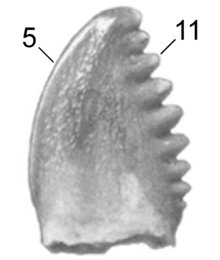Pectinodon
| Pectinodon Temporal range: Late Maastrichtian,
| |
|---|---|

| |
| Tooth of cf. Pectinodon | |
| Scientific classification | |
| Domain: | Eukaryota |
| Kingdom: | Animalia |
| Phylum: | Chordata |
| Clade: | Dinosauria |
| Clade: | Saurischia |
| Clade: | Theropoda |
| Family: | †Troodontidae |
| Genus: | †Pectinodon Carpenter, 1982 |
| Type species | |
| †Pectinodon bakkeri Carpenter, 1982
| |
| Synonyms | |
| |
Pectinodon is a genus of troodontid theropod dinosaurs from the end of the Maastrichtian age of the Late Cretaceous period (66 mya). It currently contains a single valid species, Pectinodon bakkeri (sometimes classified as Troodon bakkeri), known only from teeth.[1]
History of discovery[edit]

In 1982, Kenneth Carpenter named a number of theropod teeth from the late Maastrichtian aged Lance Formation of Wyoming as the type species Pectinodon bakkeri. The generic name is derived from the Latin word pecten, meaning "comb", and the Greek word ὀδών, odon, meaning "tooth", in reference to the comb-like serrations on the rear edge of the teeth. The specific name honors famed paleontologist Robert Thomas Bakker.[1]
The holotype, UCM 38445, consists of a 6.2 mm long adult tooth. The paratypes are three juvenile teeth.[1]
In 1985, Lev Nesov named a second species, Pectinodon asiamericanus, based on specimen CCMGE 49/12176, a tooth from the Khodzhakul Formation of Uzbekistan that dates from the Cenomanian age.[2] This is today often considered a nomen dubium.[3]
While historically considered synonymous with Troodon or more specifically the species Troodon formosus, Philip Currie and colleagues (1990) noted that the P. bakkeri fossils from the Hell Creek Formation and Lance Formation might belong to different species. In 1991, George Olshevsky assigned the Lance formation fossils to the species Troodon bakkeri.[4][5] In 2011, Zanno and colleagues reviewed the convoluted history of troodontid classification in Late Cretaceous North America. They followed Longrich (2008) in treating Pectinodon bakkeri as a valid genus[6] and noted that it is likely the numerous Late Cretaceous specimens currently assigned to Troodon formosus almost certainly represent numerous new species, but that a more thorough review of the specimens is required.[7]
In 2013, Currie and Derek Larson concluded that Pectinodon bakkeri was valid and its teeth could be found both in the Lance Formation and the coeval Hell Creek Formation. Some teeth from the older Campanian Dinosaur Park Formation could not be statistically differentiated from them, likely due to an insufficiently large sample, and were referred to cf. Pectinodon.[8]
Description[edit]
While Pectinodon is only known from teeth, its larger family Troodontidae is known from much more complete specimens. They were small, bird-like feathered bipedal maniraptorans with proportionally large eyes and brains. Like dromaeosaurids, they possessed a "sickle-claw" on the second toe of each foot. See the Troodontidae article for more information.
Pectinodon's eponymous teeth are generally small (< 1 cm crown height) labio-lingually compressed, exhibit basal constriction, and possess large, triangular, apically-oriented denticles on the distal edge. The holotype tooth has pitting on the lingual surface and no denticles on the mesial carina,[1] though other specimens are known to have fine serrations near the base of the crown on the mesial carina.[9]
Paleobiology[edit]
Despite having only teeth to infer behavior for Pectinodon, they are very informative fossils. Several studies have been done on troodontid teeth, shedding light on their behavior and ecology. Their tooth morphology suggests they preferred soft prey items like invertebrates, small vertebrates, or carrion. Their dentition was not as well suited for high-stress feeding as in their cousins the dromaeosaurids and tyrannosaurids.[10] Tooth morphology also led some researchers to speculate that troodontids were omnivorous.[11] This hypothesis was reaffirmed in a study that used stable isotopes in tooth enamel to reconstruct paleo-ecologies.[12]

See also[edit]
References[edit]
- ^ a b c d Carpenter, K. (1982). "Baby dinosaurs from the Late Cretaceous Lance and Hell Creek formations and a description of a new species of theropod" (PDF). Contributions to Geology, University of Wyoming. 20 (2): 123–134.
- ^ L.A. Nesov, 1985, "Novye mlekopitayushchie Mela Kyzylkumov", Vestnik Leningradskogo Universiteta, Geologiia, Geografiia, series 7 17: 8-18
- ^ A. O. Averianov and H.-D. Sues, 2007, "A new troodontid (Dinosauria: Theropoda) from the Cenomanian of Uzbekistan, with a review of troodontid records from the territories of the former Soviet Union", Journal of Vertebrate Paleontology 27(1): 87-98
- ^ Olshevsky, G., 1991 A Revision of the Parainfraclass Archosauria Cope, 1869, Excluding the Advanced Crocodylia. Mesozoic Meanderings 2 196 pp
- ^ Currie, P. (2005). "Theropods, including birds." in Currie and Koppelhus (eds). Dinosaur Provincial Park, a spectacular ecosystem revealed, Part Two, Flora and Fauna from the park. Indiana University Press, Bloomington. Pp 367–397.
- ^ N. Longrich, 2008, "A new, large ornithomimid from the Cretaceous Dinosaur Park Formation of Alberta, Canada: implications for the study of dissociated dinosaur remains", Palaeontology 51(4) 983-997
- ^ Lindsay E. Zanno; David J. Varricchio; Patrick M. O'Connor; Alan L. Titus; Michael J. Knell (2011). "A new troodontid theropod, Talos sampsoni gen. et sp. nov., from the Upper Cretaceous Western Interior Basin of North America". PLOS ONE. 6 (9): e24487. Bibcode:2011PLoSO...624487Z. doi:10.1371/journal.pone.0024487. PMC 3176273. PMID 21949721.
- ^ Larson D.W., Currie P.J., 2013, "Multivariate Analyses of Small Theropod Dinosaur Teeth and Implications for Paleoecological Turnover through Time", PLoS ONE 8(1): e54329. doi:10.1371/journal.pone.0054329
- ^ Longrich, Nick. "Small theropod teeth from the Lance Formation of Wyoming, USA." Vertebrate microfossil assemblages: Their role in paleoecology and paleobiogeography (2008): 135-158.
- ^ Torices A, Wilkinson R, Arbour VM, Ruiz-Omeñaca JI, Currie PJ. Puncture-and-Pull Biomechanics in the Teeth of Predatory Coelurosaurian Dinosaurs. Curr Biol. 2018 May 7;28(9):1467-1474.e2. doi: 10.1016/j.cub.2018.03.042. Epub 2018 Apr 26. PMID: 29706515.
- ^ Holtz, T.R., Jr., Brinkman, D.L., and Chandler, C.L. (1998). Denticle mor- phometrics and a possibly omnivorous feeding habit for the theropod dinosaur Troodon. Gaia 15, 159–166.
- ^ Thomas M. Cullen, Brian L. Cousens; New biogeochemical insights into Mesozoic terrestrial paleoecology and evidence for omnivory in troodontid dinosaurs. GSA Bulletin 2023; doi: https://doi.org/10.1130/B37077.1

